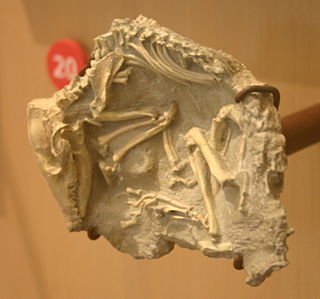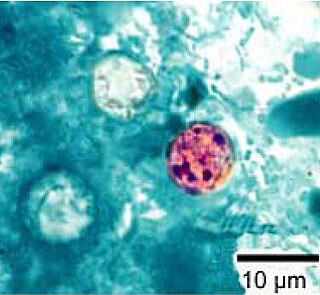
In taxonomy, binomial nomenclature, also called binominal nomenclature or binary nomenclature, is a formal system of naming species of living things by giving each a name composed of two parts, both of which use Latin grammatical forms, although they can be based on words from other languages. Such a name is called a binomial name, a binomen, binominal name, or a scientific name; more informally it is also historically called a Latin name.

Eutheria is the clade consisting of placental mammals and all therian mammals that are more closely related to placentals than to marsupials.

Ovenbirds or furnariids are a large family of small suboscine passerine birds found from Mexico and Central to southern South America. They form the family Furnariidae. This is a large family containing around 315 species and 70 genera. The ovenbird, which breeds in North America, is not a furnariid – rather it is a distantly related bird of the wood warbler family, Parulidae.

Groupers are fish of any of a number of genera in the subfamily Epinephelinae of the family Serranidae, in the order Perciformes.

Caniformia is a suborder within the order Carnivora consisting of "dog-like" carnivorans. They include dogs, bears, raccoons, and mustelids. The Pinnipedia are also assigned to this group. The center of diversification for the Caniformia is North America and northern Eurasia. Caniformia stands in contrast to the other suborder of Carnivora, the Feliformia, the center of diversification of which was in Africa and southern Asia.

Theobroma is a genus of flowering plants in the mallow family, Malvaceae, that is sometimes classified as a member of Sterculiaceae. It contains roughly 20 species of small understory trees native to the tropical forests of Central and South America.

Titanosaurus is a dubious genus of sauropod dinosaurs, first described by Richard Lydekker in 1877. It is known from the Maastrichtian Lameta Formation of India.

Acacia, commonly known as the wattles or acacias, is a large genus of shrubs and trees in the subfamily Mimosoideae of the pea family Fabaceae. Initially, it comprised a group of plant species native to Africa and Australasia. The genus name is Neo-Latin, borrowed from the Greek ἀκακία, a term used by Dioscorides for a preparation extracted from the leaves and fruit pods of Vachellia nilotica, the original type of the genus. In his Pinax (1623), Gaspard Bauhin mentioned the Greek ἀκακία from Dioscorides as the origin of the Latin name.

Danio is a genus of small freshwater fish in the family Cyprinidae found in South and Southeast Asia, commonly kept in aquaria. They are generally characterised by a pattern of horizontal stripes, rows of spots or vertical bars. Some species have two pairs of long barbels. Species of this genus consume various small aquatic insects, crustaceans and worms.

Pangasius is a genus of medium-large to very large shark catfishes native to fresh water in South and Southeast Asia. The term "pangasius" is sometimes used to specifically refer to the commercially important basa fish, P. bocourti.

Chiloglanis is a genus of upside-down catfishes native to Africa. These species have modified lips and barbels that form a suckermouth. They also have a naked (scaleless) body. Sexual dimorphism has been reported in Chiloglanis. The adult males of many of these species have elongate anal and caudal fins. Also, males may have an enlarged humeral process.
Tetracamphilius is a genus of catfishes of the family Amphiliidae. It includes four species.
Zaireichthys is a genus of loach catfishes of the family Amphiliidae.

Archaeovenator is an extinct genus of Late Carboniferous varanopid synapsids known from Greenwood County, Kansas of the United States. It was first named by Robert R. Reisz and David W. Dilkes in 2003 and the type species is Archaeovenator hamiltonensis. Archaeovenator hamiltonensis is known from the holotype KUVP 12483, a three-dimensionally preserved, nearly complete and articulated skeleton, including the skull, with limbs and girdles slightly separated from postcranial skeleton. It was collected in the Hamilton Quarry, from the Calhouns Shale Formation of the Shawnee Group, dating to the Virgilian stage of the Late Pennsylvanian Series, about 300 million years ago. The generic name is derived from the Latin Archaeo and venator, meaning "ancient hunter". The specific name is named after its finding place Hamilton Quarry. Archaeovenator is the oldest and the basalmost known varanopid, as it is the sister taxon to all other known varanopsids.
Psammphiletria delicata is a species of loach catfish endemic to Pool Malebo. It grows to a length of 2.0 cm.
Psammphiletria nasuta is a species of loach catfish endemic to the Central African Republic where it is found in the Ubangui River. It grows to a length of 2.3 cm.

Cyclospora is a genus of apicomplexan parasites. It includes the species Cyclospora cayetanensis, the causative agent of cyclosporiasis. Members of Cyclospora are characterized as having oocysts with two sporocysts, each containing two sporozoites.
Lanthanolania is an extinct genus of diapsid from Middle Permian deposits of Arkhangel'sk Province, Russia. It is known from the holotype and only specimen PIN 162/56, a nearly complete skull from the Glyadnaya Shchelya locality, Mezen river in Mesen District. It was first named by Sean P. Modesto and Robert R. Reisz in 2003 and the type species is Lanthanolania ivakhnenkoi.

The danionins are a group of small, minnow-type fish belonging to the family Cyprinidae. Members of this group are mostly in the genera Danio, Devario, and Rasbora. They are primarily native to the fresh waters of South and Southeast Asia, with fewer species in Africa. Many species are brightly coloured and are available as aquarium fish worldwide. Danio species tend to have horizontal stripes, rows of spots, or vertical bars, and often have long barbels. Devario species tend to have vertical or horizontal bars, and short, rudimentary barbels, if present at all. All danionins are egg scatterers, and breed in the rainy season in the wild. They are carnivores, living on insects and small crustaceans.

Dendrobieae is a tribe in the subfamily Epidendroideae, in the family Orchidaceae. The Dendrobieae are mostly tropical, epiphytic orchids which contain pseudobulbs.














